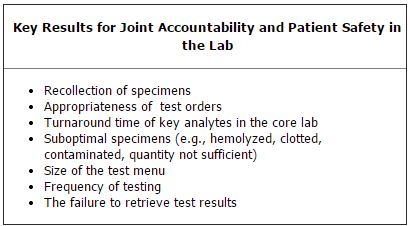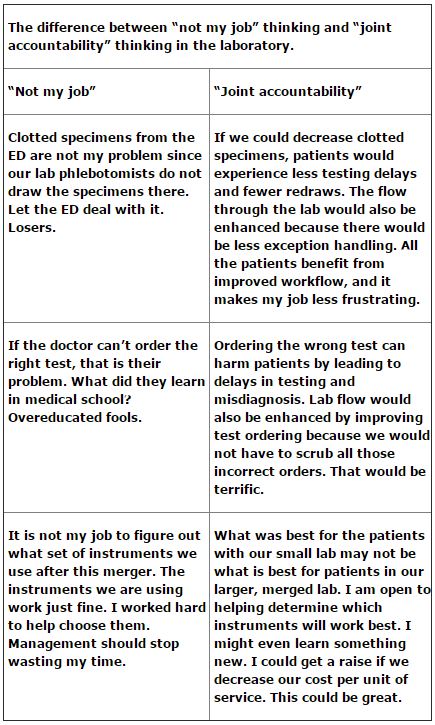As healthcare changes are driving hospitals to merge and consolidate, laboratories are faced with the challenge of maintaining safe and quality testing across a system of blended cultures. Individual and system accountability plays a key role in determining the overall safety and success of an organization. In this interview, a business world expert on accountability, Roger Connors, provides insight into creating highly functional individuals and teams to meet these challenges. He is the CEO of Partners In Leadership and a three-time New York Times bestselling author. Email: [email protected]. Partners In Leadership: 800-504-6070.
Corinne R. Fantz, PhD, DABCC, of the Patient Safety Focus editorial board conducted the interview and Michael Astion MD, PhD, also of the editorial board, contributed laboratory examples of the concepts described by Roger Connors.
Q: Why is workplace accountability important especially during mergers and acquisitions (M&A)?
Most people incorrectly think of accountability as something that happens to you when things go wrong. In M&A situations this definition can become a real problem—it sends people into the blame game, where they come up with stories to justify why something won’t work or why the whole idea of merging two organizations was just a bad idea. However, when you define accountability as a personal choice to rise above one’s circumstances and demonstrate the ownership necessary to achieve desired outcomes, you begin to get completely different results.
Rather than having a “winner” and a “loser” from any M&A activity, accountability optimizes the transition and prevents people from sabotaging it. Accountability can shift a struggling M&A to a thriving one. In fact, accountability helps individuals, teams, and organizations rise above the complex circumstances and challenges of any M&A to deliver on the dream that originally looked great on paper.
Q: A merger just resulted in our hospital acquiring three new hospital laboratories. Each lab has different instruments, laboratory information systems, call centers, couriers, and human resource departments. How would you begin the process of harmonizing these departments, eliminating redundancies, and bringing these labs under your management?
M&A success is most enhanced by one major leadership deliverable: getting clear on which key results are critical right now versus the future. Clearly defined key results unify organizations and move everyone toward an enhanced version of accountability—joint accountability.
Where individual accountability gets “me” moving, (e.g., I do these six things followed by these four), joint accountability focuses “us” on key results. Joint accountability redefines the job of every individual in the organization. While their roles and titles may not change, their hearts and minds are now engaged in the bigger job of achieving the shared key results of the organization. Instead of fighting to do things the way they have always been done, joint accountability drives all individuals to find the best way to do things, regardless of whose original system or process it might be.

Joint accountability is useful in managing laboratory mergers, mergers between laboratory sections, and in breaking down barriers between the lab and other departments.
Q: In a merger, there is usually a more dominant entity and a smaller, more vulnerable entity. What steps can lab employees take on both sides of the merger to prevent a clash of cultures?
Culture clashes are a direct outgrowth of alignment and communication failures. Can they be avoided? Absolutely. Ensuring alignment around key results is the first step. Joint accountability for those key results further aligns individuals and teams. Leaders must then listen, and listen well. Here’s how:
Recently, we worked with a hospital that was trying to reduce the amount of time spent on emergency department (ED) diversion—sending patients unnecessarily to an ED. In an onsite meeting, the outpatient clinics that were open Monday through Friday from 9 a.m. to 5 p.m. were asked to participate in analysis and problem-solving exercises to support this effort. Since it was a key result for the entire system, but not a specific outpatient clinic key result, the outpatient clinic managers said they didn’t have anything to do with the ED.
However, when we challenged them to take 5 minutes and come up with how they might impact this “ED Diversion” key result, joint accountability took them to a new place. Amazingly, one of the supervisors called us over to their discussion group and said they had a solution.
“We are notorious for not managing our outpatient clinic schedules well,” he said. “At the end of the day there are usually two people in our waiting room that haven’t been seen. They don’t wait to be rescheduled; they go directly to the ED four miles away. We know it completely bogs down the ED each night with patients that didn’t really need to be there.”
Ironically, this “not my job” group was actually having the largest impact on ED diversion. When the clinics and the ED started talking to each other, they fixed the scheduling issue and reduced ED diversion by 28% in 2 months. They realized when they looked at “our results” rather than “my job,” they found new solutions.

Q: How do you retain talented employees and minimize stress after a merger or acquisition is announced?
Again, in our experience with hundreds of leading healthcare organizations, nothing pays greater dividends than clearly defining, aligning around, and focusing on key results. The more we move people from an “activity” mindset to a results mindset, the more quickly people begin to see how what they do really matters to the organization.
We have to become very deliberate in ensuring we are communicating during the merger period. Leaders need to consistently ask for feedback, and the team needs to feel like they are being heard.
Team and organization meetings are a critical venue for this. Change your agendas to include joint accountability discussions and create a powerful experience for everyone involved.
Q: What are the biggest pitfalls for organizations during a merger or acquisition?
Every M&A can get trapped in a protracted identity crisis. Escape this by getting clear about what you want the new entity to achieve—its key results. Create greater ownership by providing a compelling why behind the key results as well as helping everyone understand how their level of involvement is critical to success. Once you become clear on key results, you can then align your strategy and your resources.
Q: Do you have any advice for laboratory employees on how to make the most of a merger or acquisition?
All change leads to some level of opportunity—something that becomes more apparent in an environment of joint accountability. Individuals who take accountability are more likely to see those opportunities—opportunities for themselves and others.